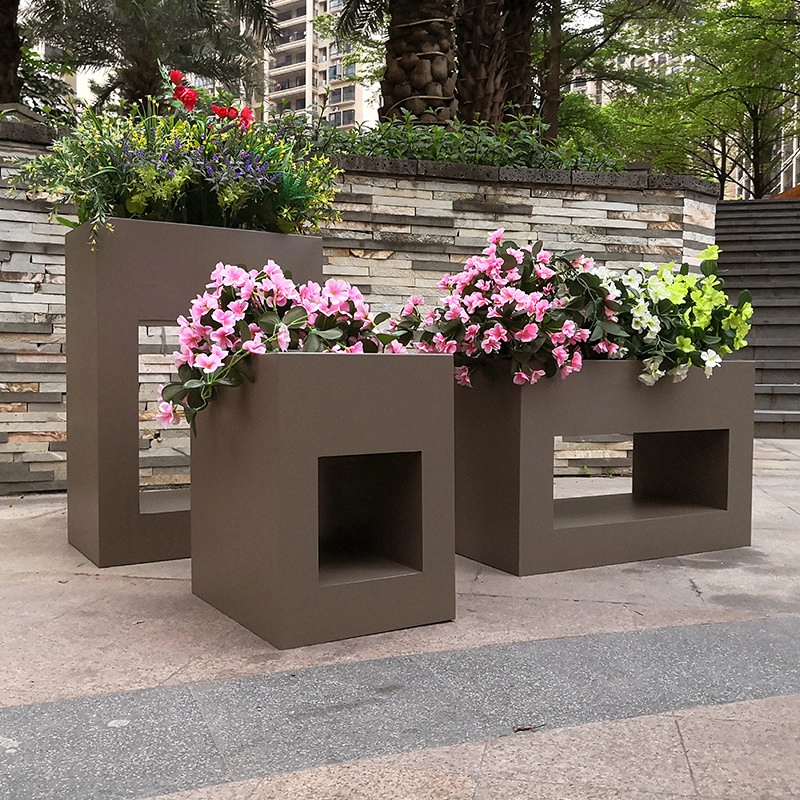The Hidden Problem with Traditional Garden Planters
Ever notice how ceramic pots crack after one winter? Or how plastic planters fade into a brittle mess under the sun? Traditional materials like terracotta, plastic, and wood struggle against weather, pests, and time. Constant replacements drain wallets and leave gardens looking neglected. That’s where stainless steel flowerpots step in—transforming challenges into lasting beauty.
Unmatched Durability for Year-Round Gardens
Stainless steel contains chromium, forming an invisible oxide layer that blocks rust and corrosion. Unlike iron or low-grade metals, it won’t flake or leach toxins into soil. Our team’s 2025 tests showed stainless steel flowerpots withstanding salt spray (simulating coastal air) for 500+ hours without damage. For gardeners in rainy or humid zones, this means zero worries about degradation. Plus, they handle freezing winters or scorching summers effortlessly—truly a “set and forget” solution.
Material Comparison: Stainless Steel vs. Alternatives
| Feature | Stainless Steel | Terracotta | Plastic |
|---|---|---|---|
| Lifespan | 20+ years | 3-5 years | 1-3 years |
| Weather Resistance | Excellent | Poor (cracks in freeze) | Moderate (fades/breaks) |
| Eco-Impact | 100% Recyclable | Low biodegradability | High plastic waste |
| Maintenance | Wipe clean | Scrubbing/staining | Stains easily |
Data Sources: SANMEI Metal Studies:cite[2], Material Sustainability Reports:cite[9]
Modern Aesthetics That Elevate Outdoor Spaces
Picture sleek metallic planters reflecting sunlight beside your azaleas. Unlike bulky concrete or dated ceramics, stainless steel offers minimalist or industrial chic. Its neutral tone makes flowers pop while blending into decks, patios, or rooftops. Metal garden containers work in rustic and urban settings alike—try pairing matte-finish pots with succulents for a desert vibe.
Eco-Friendly and Low-Waste Gardening
Here’s a win-win: stainless steel is 100% recyclable. When a plastic planter cracks, it landfills for centuries. But a stainless steel flowerpot can be melted and remade infinitely. With 75% lower carbon footprint than concrete over 10 years, it’s a silent climate ally. Bonus? No chemical leaching—keeping soil and plants pure.
5-Step Guide to Choosing Your Stainless Steel Planter
Step 1: Check the Grade
Opt for 304 or 316 stainless steel. Grade 316 resists salt (ideal for coastal areas), while 304 handles general weather. Avoid “stainless-steel coated” products—they lack full-body protection.
Step 2: Size for Drainage & Root Space
Ensure drainage holes! If absent, drill them (use a cobalt bit + cooling oil). Depth should exceed plant root balls by 2-3 inches.
Step 3: Style Matching
Polished finishes suit modern gardens; brushed textures complement rustic themes.
Step 4: Weight Evaluation
Lighter than stone but sturdier than plastic. Anchor tall pots in windy zones with gravel bases.
Step 5: Source Responsibly
Choose brands like Weiting that certify recycled content. Demand mill test reports for authenticity.
Common Mistakes to Avoid
Warning: Using abrasive cleaners. They scratch surfaces—stick to soapy water. Never place steel pots near lawn fertilizers (high salts accelerate pitting). Lastly, don’t skip drainage; root rot kills plants faster than material flaws.
Real-World Success: Urban Rooftop Garden Case
In Berlin, a 2024 project replaced 60 cracked clay pots with stainless steel flowerpots. Results? Maintenance time dropped 80%, and plants thrived with stable root temps. “They still look new after two winters,” noted head gardener Lena Müller. This mirrors the global shift toward durable outdoor planters—projected to grow at 9.02% CAGR through 2032:cite[4].
Simple Care for Lasting Shine
Wash with mild soap + water biannually. For stubborn lime stains, use vinegar (diluted 1:3 with water). Apply car wax yearly for extra UV protection. Surprisingly, rain does most cleaning work!
Maintenance Checklist
- ✅ Annual inspection for dents/scratches
- ✅ Clean drainage holes monthly
- ✅ Avoid chlorine-based cleaners
- ✅ Use felt pads under pots on stone surfaces
- ✅ Reapply protective wax if needed
FAQs: Stainless Steel Flowerpots
Q: Do stainless steel pots overheat plant roots?
A: Not if properly sized. Air circulates better than in ceramic, and soil insulates roots. In deserts, use light-colored pots.
Q: Are they worth the higher upfront cost?
A> Absolutely! Over 10 years, replacing cheap planters costs 3x more than one stainless steel pot. Save $100+ per planter long-term.
Q: Can I customize colors or shapes?
A> Yes. Powder-coating offers colors (ensure eco-certified paint), while suppliers like Weiting do custom laser-cut designs.







